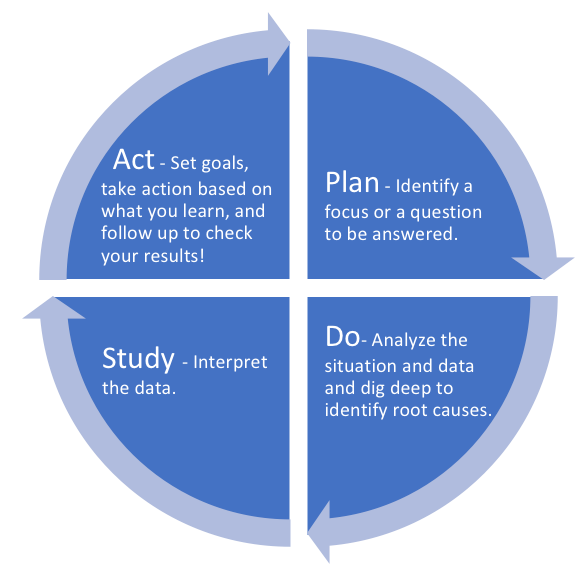- Overview
- Introduction
- Teaming for data use
- Assess your data use culture
- Prioritize your critical questions
- Assess & improve data quality
- Data culture resources
Creating a Routine: Embracing a Data-Informed Decision- Making Model
Making data-informed decision-making a routine way of doing business requires a clear, concrete, and consistent approach. There are many well-known models, such as the Plan, Do, Study, Act process used in health care and business and the Data Wise process used in education. Organizations also may choose to define their own process and language.
Because many of these models share similar components (such as plan, do, study, act), this section describes the implementation of these components with the expectation that your organization will modify them as needed.
In this (and similar) models, the approach is cyclical and continuous. Wherever you enter the cycle, think about where you are in the process and how it relates to the entire Plan, Do, Study, Act cycle. The main points are to
- look purposefully at your data,
- choose the most relevant analyses,
- use the results of the data, and
- then plan next steps.
Further, regardless of the approach, integrating the Plan, Do, Study, Act process into any team’s daily work takes leadership, repetition, and time.
- It needs to be communicated to people,
- put into practice to answer critical questions and address problems, and
- repeated over time to have a lasting effect.
This can be hard work and takes time, but the payoffs are well worth the effort.
What are the payoffs of implementing a process?
First, a clearly articulated process, with named steps and protocols for executing them, gives team members a common approach and language. Initially, this approach may seem like a recipe to be followed, but over time team members will internalize the steps, and the process will become an automatic way of working together. Team members will begin to ask to see the data related to goals that have been set, inquire what results the team can expect from a course of action, and hold each other accountable for sharing results and identifying next steps. The team members will have adopted a common language and a standard way of working together on decision-making. The decision-making process will have become a cultural norm.
Second, changing a habit by yourself is difficult. Making that change in collaboration with others provides support to keep going when the going gets tough. When you are analyzing data about a problem and exploring underlying causes, you may find that a change in the way things have been typically done is necessary to achieve different results. Engaging a team in the analysis helps the team members understand the problem and the factors that create and sustain it and be involved in crafting the change that is needed. Equally important, proven protocols for analyzing data and reflecting on root causes can help a team have tough conversations about challenging issues in a safe and supported environment. A data-informed decision-making process will help teams dig into a problem and a mountain of data and come out with a common understanding of the work ahead.
Third, the greatest payoff from implementing a data-informed decision-making process is that the benefits are clear. By using a process that includes measurable benchmarks and clearly defined goals, your team will be able to monitor its work toward the solution and adapt as necessary to achieve the desired result. Without ongoing data use in monitoring the action plan, the change may never get off the ground. The model gives team members the tools to assess their work as it progresses and ask, “How are we doing?” and “What help do we need?” The process helps sustain initial buy-in and ensure the eventual result.
Choosing a model and implementing it fully are important to making a real change in the way people collaborate and work. With repetition, the data-informed decision-making process will improve the results that matter most to your team. It will give team members clarity about what is important and an investment in achieving results.
Published August 2017.


